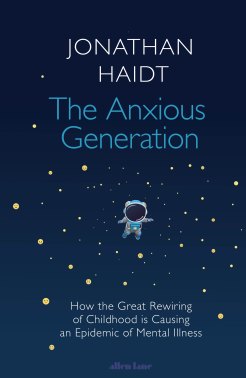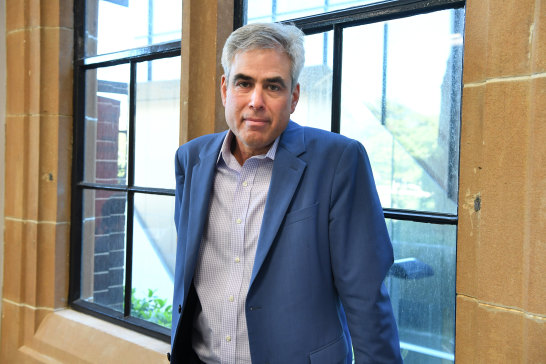By Andrew Leigh
SOCIETY
The Anxious Generation: How the Great Rewiring of Childhood is Causing an Epidemic of Mental Illness Jonathan Haidt
Allen Lane, $36.99
Around 2007, two significant events occurred. First, the rise of the smartphone and social media. Within a few years, iPhones and Android phones became ubiquitous, and platforms such as Facebook, Instagram, and Twitter exploded into popularity. The second development was a noticeable decline in youth mental health. Across advanced countries, rates of anxiety, depression, self-harm, and suicide worsened, especially among girls.
Is there a connection between these two developments? In The Anxious Generation, New York University social psychologist Jonathan Haidt makes the strongest case yet that smartphones and social media are doing massive harm to the mental wellbeing of young people. Like Jean Twenge’s iGen and Netflix’s The Social Dilemma, this is an urgent call to action, from a writer who regards social media as more akin to tobacco than fairy floss.

Jonathan Haidt’s book argues that smartphones and social media are doing massive harm to the mental wellbeing of young people.Credit:
What’s the evidence? Over the past 15 or so years, the use of smartphones and social media has skyrocketed. The average young American receives 192 social media notifications daily. Nearly half of US teens say they are online “almost constantly”. Device use has displaced in-person activities. Young US teens are increasingly unlikely to have a part-time job or a driving licence.

The Anxious Generation by Jonathan Haidt.
The mental health crisis is similarly dramatic. Since 2007-2010, rates of anxiety and depression among young people in the US have doubled. More than one-third of US university students report feeling anxious “most of the time”. Among teen girls, rates of self-harm have doubled.
Haidt argues that social media’s impact has been most pronounced among girls because they use the platforms more, and because girls tend to be more susceptible to social comparisons. In a society that judges young women based on their appearance, Instagram filters set an impossible standard, leaving many girls feeling anxious and depressed.
The teen mental health crisis isn’t only a US phenomenon. Haidt presents evidence from various advanced nations, including Canada, Britain, Ireland, New Zealand, Finland, Sweden, Norway, Denmark and Iceland. The “great rewiring of childhood” affected teens across the globe.
The Anxious Generation includes some evidence for Australia, but as I read it, I grew more curious about the extent to which the worsening of teen mental health had occurred here. That prompted me to delve into the data, to see what kind of picture it painted about the mental wellbeing of young Australians.
The pattern I uncovered for Australia suggests that the problem is nearly as concerning here. Since 2007, the share of young Australian women reporting anxiety disorders has doubled, from 20 per cent to 40 per cent.
Over the same period, the rate of self-harm hospitalisations for young women is up by 43 per cent, while the suicide rate has risen by 70 per cent. Anxiety, self-harm and suicide have worsened for Australian boys too, though in most cases, the rise is less dramatic than for girls.

Jonathan Haidt argues that social media’s impact has been most pronounced among girls because they use the platforms more.Credit: Peter Rae
Yet as any good social scientist knows, correlation does not imply causation. Just because two trends coincide does not mean that one caused the other. Could there be other factors at play?
One way to address this question is to explore the perspectives of young people themselves. A survey of Australian teens asked them why they believe their generation’s mental health has deteriorated. The top answer was “social media”.
Further evidence comes from the early years of Facebook’s introduction to US universities. As Facebook became available on a campus, students’ mental health declined. Still more evidence comes from randomised trials that asked young people to reduce their social media use for a few weeks. Those who spent less time on social media became less lonely and depressed.
Alternative theories just don’t fit the data. For example, the mental health crisis was afoot before COVID. Anxiety of climate change also seems an unlikely explanation, partly because it’s hard to see why it should have affected girls more than boys.
What can we do about it? Haidt argues that parents have become overprotective in the real world, and underprotective in the virtual world. To cultivate resilience, children need exposure to setbacks and stumbles, so it is important not to cocoon them. He advocates a complete ban on phones in schools, urges parents to delay giving smartphones to their children, and extols the benefits of outdoor activities.
Given the scale of the problem, these solutions may seem insufficient, but they represent the beginning of a movement towards putting smartphones in their place, building community and supporting the wellbeing of young people.
Andrew Leigh is a member of the Australian Parliament. His latest book is The Shortest History of Economics.
The Booklist is a weekly newsletter for book lovers from books editor Jason Steger. Get it delivered every Friday.